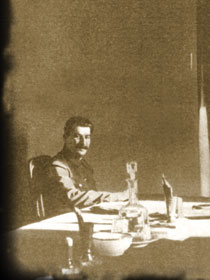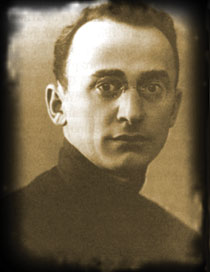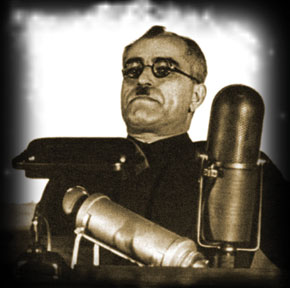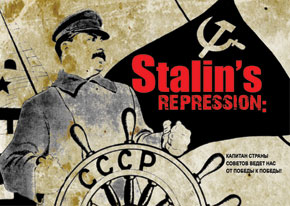 Pages 50-54
Pages 50-54By Karim K.Shukurov
Repression in the Soviet government: beginnings and transformation
Repression gouged a red line through the history of Soviet government (1917-91). The base was laid by V.I.Lenin (1917-24) founder of the state, but it took on unprecedented dimensions during J.V.Stalin’s supremacy (1923-53). As a result, post-Stalin Soviet leaders inherited a rather passive society governed by strong ideological principles. Nikita Khrushchev (1953-64) who was the first to challenge Stalin’s repression at state level, was nonetheless unable to resist the resort to unlawful punitive measures. However, from his time onwards there were changes in form. Mass physical destruction was transformed into moral pressure. Under Leonid Brezhnev (1964-1982), Yuri Andropov (1982-84) and Konstantin Chernenko (1984-85) repression was gradually eased out and the persecution of dissent took on new forms (the fates of Nobel Prize laureate, physicist Andrei Sakharov (1921-89), writer Alexandr Solzhenitsyn (1918-2008) and others may serve as examples). Mikhail Gorbachev (1985-91), who oversaw the destruction of the USSR, revived the repression of Soviet history.
Thus it is clear that, for all its zigzag progress, repression was a natural process of the Soviet era.
Terminology: from definition to essence
In the Soviet state the forms of repression were reflected in the language used. Under Lenin and Stalin official documents referred to a struggle against enemies of the Soviet state, parricides and others, but later documents cited an ideological struggle. The concept of repression (from Latin – press back) and the rehabilitation (from Latin – make able again) related to it, belong to the period following Stalin’s death (1953). At the 20th Congress (14-25 February 1956) of the Communist Party of the Soviet Union (CPSU), in a secret speech on 25 February 1956, Khrushchev, First Secretary of the Central Committee, used these expressions to describe the political processes of the 1930s-50s and the elimination of their consequences. Since then these expressions have been embedded in the Soviet political and historical lexicon.
This heritage continues to this day and these terms are now accepted. In fact, the historical truth is that these terms are not adequate to describe the illegal punitive measures applied to innocent people in the Soviet period; the difficulty is that it seems impossible to change these terms. The best solution is to determine the essence of these terms correctly. The political essence of repression was state terrorism (either physical or moral). As with repression, the essence of rehabilitation, indicating the elimination of its consequences, should also be clarified. It is not right that this term simply means a declaration of the innocence of the victim. Rehabilitation should also declare the crimes of the Soviet state against its citizens and its responsibility for the consequences.
New judgements on the causes
Nowadays, as it was in the mid 1950s, Stalin’s repression is considered separately from the general repressiveness of the Soviet system and its causes have not been fully determined. Subjective factors (Stalin’s incorrect theoretical views, his deviations from Lenin’s political line etc.) have been the main focus. However, the root of the matter lies deeper. A comprehensive approach is needed to cover all the factors behind Soviet repression and its causes can be divided into general factors and the particular personalities of each Soviet leader and his time.
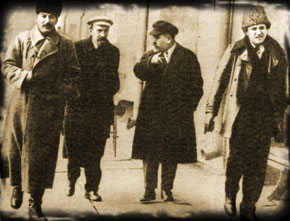 Stalin, A.I.Rykov, G.y.Zinoviev, early 1920. The three men on the right were later repressed by Stalin
Stalin, A.I.Rykov, G.y.Zinoviev, early 1920. The three men on the right were later repressed by Stalin Among the general factors, the Soviet political system and the Soviet state at its centre stand first and foremost. The Soviet state, denying every tradition of statehood, including those of the tsarist Russia from which it emerged, developed as an anti-historical political construct in the name of a proletarian dictatorship. In this state a political-ideological organization, the Communist Party, occupied government, rather than the rule of law and social challenge. This political system was established under the influence of a physically tormented Lenin (22 April 1870 – 21 January 1924), who suffered from incurable disease at the end of his life (even professional historians have neglected this point). It is often stated that the plan for building socialism in the USSR (industrialisation, collectivisation, cultural revolution) was developed in Lenin’s last articles, the so-called political testament, particularly in the Letter to the Congress (23 December 1922 – 4 January 1923). But Lenin’s conception of the Soviet political system, which had such an important role, has been neglected. To be specific, Lenin promulgated the idea that the Communist Party should be superior to the state in the political system and, more importantly, he insisted that this should be the case. This idea was later legalized in the Soviet constitution (article six of the last Soviet constitution was abolished only in 1990). Thus, a single-party Soviet political system, with the Communist Party governing the state, was formed in the USSR. This political system relied upon dictatorship and the ideological victors in resolving personal problems and those of civil society. That is why repression in one form or another became an attribute of state policy.
It may seem strange but, together with the Soviet political system, the contradictory positions of the international community, particularly of the world’s leading countries, towards the human rights violations and repression of innocent people in the USSR, should be mentioned among the general reasons for Soviet repression. When its citizens became prisoners of the political system within the USSR, they needed support, but the West stood by and hoped that the USSR would weaken from within. Only in the mid 1970s was increased international attention given to human and civil rights issues in the USSR, with the adoption of the Helsinki Final Act.
The personalities of party leaders (who were, at the same time, heads of state) in the Soviet political system and their actions, which were not regulated by any law, also had a decisive influence on repression; this was particularly true of Stalin.
Stalin: from priesthood to dictatorship
Joseph Dzhugashvili (he adopted the pseudonym Stalin in 1913), a young man born into the family of a shoemaker and modest peasant girl, initially chose the priesthood as his vocation. He graduated from the Gori religious school (1894) and entered the Orthodox Seminary in Tiflis, but was expelled from the graduation class (1899). Eighteen years of revolutionary activity turned him into one of the leaders and, later, to dictator of the world’s first socialist state.
Much has been written about the role of Stalin’s personality vis-a-vis the repression, but his environment must be mentioned here as a new consideration. At that time, the administration of the Communist party, Lenin in particular, had a negative impact. The appraisal given of the personalities of Stalin and other party leaders in the above-mentioned Lenin’s Letter to the Congress is well known. But these steps, taken by Lenin when he was dying, have been considered unilaterally (as have concerns about the fate of the party etc). Of course, Lenin took his secret with him to the hereafter. But it may be that with this letter he initiated a deep quarrel between the party leaders and engendered a struggle for power (this became a tradition in later periods, all the Soviet leaders came to power by means of intrigue rather than in by democratic means). It is very interesting that in the Letter to the Congress, the toughest line was taken against Stalin. It is clear that this was influenced by personal hostility (Stalin had been rude to Lenin’s wife Krupskaya). Lenin’s bias against Stalin gave impetus to his struggle for power and aggrevated his confrontation with rivals, especially in the conditions then prevailing.
Surviving party leaders strengthened Stalin´s position from the opposite direction. Trotsky (1879-1940) made a big mistake in not treating him as a serious rival. The union with Kamenev (1883-1936) and Zinoviev (1883-1936) guaranteed Stalin’s triumph (1923-25) over Trotsky (who was sent into foreign exile in 1929 and murdered in 1940). After that he liquidated his former allies (1925-27) Kamenev and Zinoviev, together with Bukharin (1888-1938) and Rykov (1881-1938). During the political trials of 1935-38 all four of them were tried and shot. Thus, after Stalin had rid himself of the entourage that had brought him to power, he formed a new team to serve the purposes of his dictatorship. Their characteristics are also interesting. There were two groups: the constant and the changing. M.I.Kalinin (1875-1946), V.M.Molotov (1890-1986) and others belonged to the first group. Prosecutor A.Y.Vyshinsky (1883-1954), People’s Commissars for Internal Affairs H.G.Yagoda (1891-1938), N.I.Yezhov (1895-1940), L.P.Beria (1899-1953) and others comprised the second group. It was a real death squad.
Stalin’s repression or, unilateral war
In order to demonstrate the truth of this description, let’s look at the facts: the figures for human loss in the Great Patriotic War (1941-45), one of the main phases of the Second World War, vary between 7 and 27 million people (according to Stalin in 1946, 7 million were lost; according to Khrushchev in 1956, it was 20 million; according to Gorbachev in1985, it was 27 million people).
Based on official information for 1930-53, about 3.8 million people were accused of working against the state or other such crimes and about 800,000 of them were shot. According to other calculations, from 1930-41 alone, 20 million people were victims of repression as parricides. If we include those victimised from 1941-1953, the total statistical picture of Stalin’s repression becomes clearer (This is such a broad issue that we can only consider it here in general terms; we cannot go into the preparation of repression, its implementation, the dramatic effect on the lives of the victims etc.)
As we see from the comparison, by the simplest calculations (the impossibility of determining the exact human loss to the state may also regarded as strange) the loss of life during Stalin’s repression, or the number of people repressed, is almost equal to the USSR’s losses in World War II. If the material (the expense incurred in fostering those people as citizens, their property etc.) and moral cost of repression are considered, then it was much more disastrous than World War II. If we tally those who prepared the death sentences for these people, the executioners and the arms used to shoot these people, the organization and maintenance of the concentration camps, in general, the whole organisation of the repression machine, there is further proof that it was a true war.
But the tragedy of this war was that all the country’s military, political and administrative resources were directed against innocent people. Stalin’s strategy and tactics show that it was a unilateral war. The facts prove that the repression was not simply the outcome of a sick man’s ambition, as has been said. It was a well-planned and administered operation. Initially directed against political rivals, then against important party, state, military and other figures, the campaign gradually extended to the lower strata and, finally, was turned against potential ‘enemies’. Repression embraced the whole of the USSR, without exception. Let us examine its phases and how they supplemented each other: in the late 1920s and early 30s, repression intensified; from 1933-34 it was eased; from 1934-36 (following the assassination of S.M. Kirov, secretary of the Leningrad Oblast Party Committee in 1934) it was renewed and reached its peak in 1937and 1938 (at that time people were repressed by lists. From 1937-38 Stalin received 383 such lists from People’s Commissar for Internal Affairs Yezhov and issued sanctions detailing penalties); from 1939-1941 repression eased; but was again reinforced from 1941-1945 (the deportation of nations – Chechens, Ingush, Crimean Turks and others – may be included here); 1946-47 saw a relaxation but the late 1940s and early 50s witnessed another wave.
Stalin’s repression in Azerbaijan: general and particular features
The determined centralization of USSR management is clear from the conduct of Stalin’s repression. The scenario in Azerbaijan reflected that which prevailed throughout the country. At the same time, each region had its own peculiarities. Although Azerbaijan was the first Soviet republic in the South Caucasus (28 April 1920), Moscow demonstrated little confidence in it. Azerbaijanis were excluded from the state administration by all means and any move against the Soviet state was ruthlessly suppressed by the army. The first Soviet leader of Azerbaijan was transferred away from the republic in 1922 on the pretext of a job in Moscow. Until 1934 the country was governed by non-Azerbaijanis. Anti-Soviet rebellions, increasing due to the loss of independence were answered with severe reprisals. Repression, intensified following Kirov’s murder (1934), coincided with a change of regime in Azerbaijan: M.J.Baghirov had risen to power (1934-1953). Thus the most intensive period of Stalin’s repression coincided with Baghirov’s administration in Azerbaijan. The fact that Baghirov remained in power for so long had a bilateral affect on repression. On the one hand, the length of his stay in this era indicated strict adherence to his leader’s will. On the other hand, stable leadership in the republic, in his person, possibly avoided new forms of repression that might have emerged with changes of power. The preparation and conduct of repression was based on a consistent mechanism in Azerbaijan. The death squad of the ‘law enforcement agencies’ (the Peoples Commissariat for Internal Affairs, the Chief Political Department etc.) was organized under Baghirov’s control. A significant point here is that non-Azerbaijanis dominated (Y.D.Sumbatov-Topuridze, K.Grigoryan, T.Borshev, S.Yemelyanov, R.Markaryan).
Among the victims of the political processes in Azerbaijan were state and Communist Party servants, engineering and technical personnel, famous scientists, poets and writers. But repression gradually embraced a broad section of the population. Mass repression was carried out in the regions (Ismayilli, Shamakha etc.) ostensibly to prevent anti-Soviet rebellion. Convictions in Azerbaijan were for Turkism, cooperation with the nationalist Musavat (Equality) party, attempts on Baghirov’s life etc.
Materials revealed at Baghirov’s trial give a remarkable insight into the repression in Azerbaijan. The official position was also revealed at this trial, which was one of the most sensational events of the Khrushchev era. The fact that Baghirov indirectly acknowledged his guilt only adds to its significance. He said:
My main mistake was that I turned a blind eye to Beria and others who were close to him: Sumbatov, Borshev, Grigoryan, Markaryan. I defended his hostile position and I did not recognize its true direction. I believed these people and entrusted them with the organs of the NKVD (Peoples Commissariat for Internal Affairs). Here my guilt before the people is great, and I shall be shot, hung, quartered or dismembered.
As was the case across the USSR, the exact number of victims of repression in Azerbaijan has not been determined. We can only estimate that from 1937-38 their number might exceed one hundred thousand.
Stalin’s methods were not restricted to the physical liquidation of people, exile, destruction in concentration camps and forced labour. As mentioned above, deportation was an integral component. In late 1936, a decision was taken to deport South Azerbaijanis who had once migrated from Iran. This led, in early 1937, to thousands of people being expelled from the country or sent into exile to Central Asia and Kazakhstan. In 1941, the deportation of Germans was completed (the first group of Germans had been accommodated here by Tsarist Russia in 1817). But one of the greatest tragedies was that between 1947 and 1953, about one hundred thousand Azerbaijanis were displaced from their historical lands of Western Azerbaijan ( the Armenian SSR has been established on those lands in 1920). The deportations ceased with Stalin’s death.
Soviet rehabilitation of Soviet repression
Although we acknowledge that the truth about Soviet repression has been disclosed to some extent, we cannot say the same about rehabilitation. One of the last official opinions was given in the collection entitled Rehabilitation: The Political Processes of the 1930s-50s, published in 1991 under the general editorship of Academician A.N.Yakovlev, who was close to Gorbachev and a member of the Politburo (1987-90). Even when perestroika (reconstruction) and glasnost (openness) were declared in the Soviet period, the responsibility for rehabilitation from repression was not mentioned. The Soviet nations that were victorious in the war of 1941-1945, could not rise against Stalin’s repression, or his so-called unilateral war. People did not achieve rehabilitation, it was granted by the Soviet state. The transcription of Khrushchev’s secret speech to the 20th congress of the CPSU was published in Yakovlev’s book. There are some very interesting details. Khrushchev released terrible facts about Stalin’s repression, and the reaction of congress representatives, i.e. the party elite, to those facts was also registered in the transcript. After each description it records movement in the hall, animated response in the hall, and angry noise in parenthesis. That explains everything. People’s attitudes towards rehabilitation were approximately the same. Stalin’s repression aroused almost no protest within society. The Soviet state carried out the rehabilitation process to suit its own purposes or, as in the Brezhnev period, simply put it to one aside. It was a Soviet-style rehabilitation and was neither complete nor comprehensive. A real process of rehabilitation with full restoration of the human and civil rights that were violated is still urgently required in the independent republics that emerged in the post-Soviet region. Literature
1. Bunyadov Z. Red Terror. Baku, 1993
2. Mir Jafar Baghirov’s trial (Archive materials). Baku, 1993
3. Shukurov K. The Democratic Situation in Azerbaijan (1920-41) // In The World Of Books, 1991, №1-2, p.84-86
4. Inquisitor: Stalin’s Prosecutor Vyshinsky. М., 1992
5. Kojinov V. The Truth of Stalin’s Repression. М., 2008
6. Medvedev R. About Stalin and Stalinism. М., 1990
7. TheTruth and Nothing but the Truth (‘White spots’ on Our History). Baku, 1991
8. Rehabilitation: The Political Processes of the 1930s-50s / ed. А.N.Yakovlev. М., 1991
9. Stalin’s Deportations. 1928-1953. ed. А.N.Yakovlev. М., 2005
10. Tsaplin V.V. The Statistics of the Victims of Stalinism in the 1930s // Questions of History, 1989, №4, p.175-181
11. Tsaplin V.V. Archive Materials on the Number of Prisoners at the End of the 1930s // Questions of History, 1991, №4-5, p.157-163
